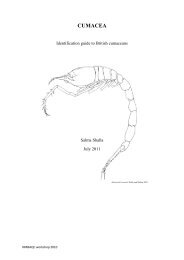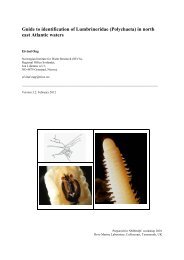s A Field Guide to the British Seaweeds - NMBAQC
s A Field Guide to the British Seaweeds - NMBAQC
s A Field Guide to the British Seaweeds - NMBAQC
You also want an ePaper? Increase the reach of your titles
YUMPU automatically turns print PDFs into web optimized ePapers that Google loves.
Polysiphonia spp.<br />
These plants are filamen<strong>to</strong>us and<br />
polysiphonous but will vary<br />
considerable between species. The<br />
colour may be light pink <strong>to</strong> deep red<br />
and purple or black. The number of<br />
primary siphons range from 4 <strong>to</strong> 24<br />
and depending on <strong>the</strong> species<br />
secondary siphons may also be<br />
present. These characteristics are<br />
used <strong>to</strong> distinguish between species.<br />
Cys<strong>to</strong>carps<br />
Secondary siphons<br />
Some Polysiphonia species<br />
may only have 4 <strong>to</strong> 6<br />
primary siphons o<strong>the</strong>rs<br />
may have secondary<br />
siphons present, often <strong>the</strong><br />
central siphon cannot be<br />
easily seen<br />
Reproductive bodies may be present as cys<strong>to</strong>carps or tetraspores<br />
Tetraspores<br />
They may be found in a number<br />
of habitats throughout <strong>the</strong> lit<strong>to</strong>ral<br />
including rockpools, overhangs<br />
and crevices and may also be<br />
located in amongst turf formers.<br />
Shape, size and location of <strong>the</strong><br />
reproductive bodies are also<br />
quite variable.




